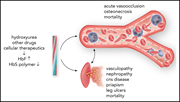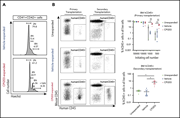Issue Archive
Table of Contents
BLOOD COMMENTARIES
PLENARY PAPER
RUNX1 and CBFβ-SMMHC transactivate target genes together in abnormal myeloid progenitors for leukemia development
In a Plenary Paper, Zhen and colleagues provide novel molecular insights into the requirement for Runx1 in a mouse model of inversion(16) acute myeloid leukemia (AML). They challenge the prevailing RUNX1 repression model of this disease, showing that RUNX1 and CBFβ-SMMHC mainly function together as activators of gene expression through direct target gene binding and that RUNX1 is indispensable for inversion(16) AML development. These insights should facilitate the development of therapeutics that target RUNX1/CBFβ-SMMHC interaction.
REVIEW ARTICLES
Fetal hemoglobin in sickle cell anemia
In this timely review, Steinberg explores new insights into the genetic and biological basis of variations in fetal hemoglobin and its ameliorating influence on sickle cell disease (SCD). This framework enables a discussion of past and current clinical trials of cell-based therapeutics, including gene editing approaches, that may portend curative treatment regimens for SCD.
CLINICAL TRIALS AND OBSERVATIONS
A phase 1b study of AFM13 in combination with pembrolizumab in patients with relapsed or refractory Hodgkin lymphoma
Clinical Trials & Observations
Bartlett et al report the early-phase safety and efficacy of a 2-agent 3-pronged immunotherapy regimen targeting specific immunologic characteristics of Hodgkin lymphoma. AFM13 is a bispecific antibody engaging Hodgkin and Reed Sternberg (HRS) cells via CD30 and natural killer (NK) cells via CD16A. In combination with pembrolizumab to relieve the blockade by PD-L1 of NK cell activity, response rates exceeded 80%, with complete metabolic responses in 46% of patients.
HEMATOPOIESIS AND STEM CELLS
The BET inhibitor CPI203 promotes ex vivo expansion of cord blood long-term repopulating HSCs and megakaryocytes
Brief Report
BET (bromodomain and extraterminal motif) proteins play an important role in the epigenetic regulation of hematopoietic stem cell (HSC) maintenance in mice. Hua at al demonstrate that adding the BET inhibitor CPI203 to a cytokine cocktail expands serially transplantable human cord blood HSCs and enhances their potential to differentiate into megakaryocytes.
IMMUNOBIOLOGY AND IMMUNOTHERAPY
CD38 deletion of human primary NK cells eliminates daratumumab-induced fratricide and boosts their effector activity
LYMPHOID NEOPLASIA
CANOMAD: a neurological monoclonal gammopathy of clinical significance that benefits from B-cell–targeted therapies
CME
Clinical Trials & Observations
CANOMAD (chronic ataxic neuropathy, ophthalmoplegia, immunoglobulin M [IgM] paraprotein, cold agglutinins, and disialosyl antibodies) is a rare syndrome characterized by chronic neuropathy with sensory ataxia and ocular and/or bulbar motor weakness in the presence of a monoclonal IgM reacting against gangliosides. In this month’s CME article, Le Cann et al report a large series of this very rare syndrome, revealing that one-third of patients harbor an overt hematological malignancy such as Waldenström macroglobulinemia and suggesting that intravenous Ig and rituximab-based regimens are effective therapies.
MYELOID NEOPLASIA
Synergistic targeting of FLT3 mutations in AML via combined menin-MLL and FLT3 inhibition
Dzama and colleagues explored the preclinical potential of combining small-molecule inhibitors that disrupt a key protein-protein interaction maintaining the stem cell state with established inhibitors of FLT3 kinase in NPM1-mutant and KMT2A-rearranged leukemias. They demonstrate enhanced differentiation and reduced proliferation with the combination and improved in vivo efficacy.
RED CELLS, IRON, AND ERYTHROPOIESIS
Iron chelation rescues hemolytic anemia and skin photosensitivity in congenital erythropoietic porphyria
Congenital erythropoietic porphyria (CEP) is an autosomal disorder of heme synthesis in which the buildup of phototoxic metabolites in red cells leads to disfiguring skin lesions and hemolysis. Blouin et al provide a mechanistic basis for iron chelation to reduce porphyrin accumulation in this debilitating disease and demonstrate reversal of hemolytic anemia and skin photosensitivity in CEP mice. This study paves the way for clinical trials of this approach.
THROMBOSIS AND HEMOSTASIS
LETTER TO BLOOD
Patients with refractory catastrophic antiphospholipid syndrome respond inconsistently to eculizumab
Clinical Trials & Observations
BLOOD WORK
ERRATUM
CONTINUING MEDICAL EDUCATION (CME) QUESTIONS
-
Cover Image
Cover Image
![issue cover]()
293T cells were cotransfected with plasmids expressing mCherry-truncated RUNX1 and EGFP-CBFβ, and confocal microscopy was used to detect the interaction between truncated RUNX1 (red) and CBFβ (green) proteins. A merged image of these 2 proteins is shown. See the article by Zhen et al on page 2373.
- PDF Icon Front MatterFront Matter
- PDF Icon Table of ContentsTable of Contents
- PDF Icon Back MatterBack Matter
- PDF Icon Editorial BoardEditorial Board
Advertisement intended for health care professionals
Email alerts
Advertisement intended for health care professionals














RUNX1 and inv(16) are frenemies in AML